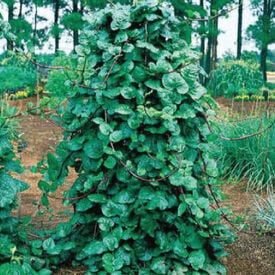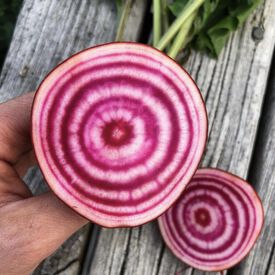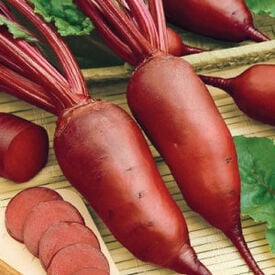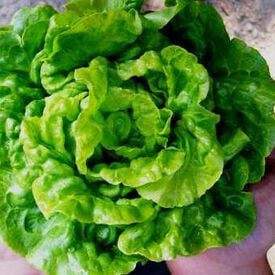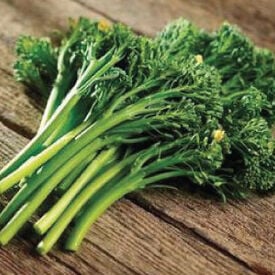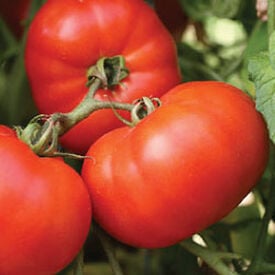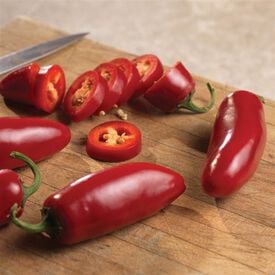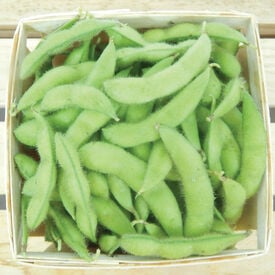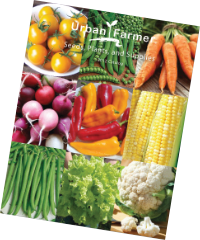The Malabar Red Stem Spinach is a beautiful climbing spinach that looks and taste great! This vigorous climbing vine needs to be trellised and grows into fall. This spinach variety has a taste that resembles a mild Swiss chard. Use Malabar Red Stem's leaves and young stems sparingly in salads or stir-fries.
The Vivian lettuce is a tightly bunched romaine with broad dark green crisp leaves. Its leaves are 12-16 in. long and 4-6 in. across. Vivian is bolt resistant and suitable for commercial and home growers. Its erect dark green leaves are great for baby leaf production.
Federle tomatoes, also known as Federle's Italian Paste, are a unique and heirloom variety of tomato renowned for their distinctive characteristics and rich history. These tomatoes typically exhibit a medium-sized, elongated shape, resembling a classic Roma tomato. Their size can range from 3 to 5 inches in length, making them ideal for canning, sauces, and paste production. Federle tomatoes thrive in specific growing conditions. They require full sun exposure and well-drained, fertile soil to flourish. These tomatoes are known for their resilience and adaptability, making them suitable for various climates and regions. They are often treasured by gardeners for their consistent performance and robust growth, making them a reliable choice for home gardeners and small-scale farmers. The history of Federle tomatoes dates back to Italy, where they have been cultivated for generations. These tomatoes were brought to the United States by Italian immigrants in the late 19th and early 20th centuries. Since then, they have become a cherished heirloom variety, cherished for their exceptional flavor and versatility in the kitchen. Federle tomatoes are a testament to the enduring legacy of traditional tomato cultivation and continue to be a favorite among those who appreciate the rich heritage and exceptional taste of heirloom vegetables.
Chioggia beets, also known as Candy Cane or Bull's Eye beets, are a unique and visually striking variety of beets that originated in Italy. Their history dates back to the early 19th century when they were first cultivated in the coastal town of Chioggia, near Venice. These beets are renowned for their vibrant and eye-catching appearance, characterized by concentric rings of alternating red and white colors, reminiscent of a candy cane. This distinct coloration makes them a popular choice among gardeners and chefs for their ornamental and culinary appeal. In terms of taste, Chioggia beets offer a mild and slightly sweet flavor, making them a versatile ingredient in various dishes. They can be enjoyed raw in salads, pickled, roasted, or boiled, and their taste becomes sweeter when cooked. Typically, Chioggia beets are round to slightly flattened in shape, with a diameter of 2 to 3 inches. They are known for their relatively quick maturity, taking around 50 to 60 days to reach full size. Their unique coloration is retained even after cooking, making them a visually stunning addition to any meal. When it comes to growing Chioggia beets, they thrive in well-drained soil with a neutral pH and require full sun for optimal growth. Proper spacing is essential to allow room for their roots to develop, typically requiring 3 to 4 inches between each plant and rows spaced about 12 to 18 inches apart. Chioggia beets are relatively disease-resistant, with a natural ability to withstand some common beet diseases, but it's still essential to monitor them for any signs of issues. With proper care, Chioggia beets can yield a bountiful crop, and their unique appearance and delightful taste make them a favorite among gardeners and culinary enthusiasts alike.
Cylindra beets, also known as "Formanova" or "Butter Slicer," are a unique variety of beetroot known for their elongated, cylindrical shape. These beets have a fascinating history, originally hailing from Europe, particularly Denmark, where they were developed in the early 20th century. Their distinctive shape was cultivated to make them easier to slice and can, a practical innovation that has made them popular among home gardeners and commercial growers alike. In terms of taste, cylindra beets are mild and sweet, with a slightly earthy flavor. They are known for their tender, non-fibrous texture, making them excellent candidates for pickling, roasting, or slicing thinly for salads. Their deep red-purple skin contrasts beautifully with the vibrant, dark red flesh inside, adding an attractive element to culinary dishes. Cylindra beets typically grow to be 6-8 inches in length and 2 inches in diameter. They are ready for harvest in approximately 55-65 days from planting, making them a relatively quick-growing beet variety. They thrive in well-drained, loamy soil with full sun exposure. When it comes to disease resistance, cylindra beets tend to be more resistant to common beet diseases like leaf spot and powdery mildew than some other beet varieties. Proper spacing is crucial, with about 2-3 inches between each plant and rows spaced 12-18 inches apart. With the right care and growing conditions, cylindra beets can yield a bountiful crop of these delicious and uniquely-shaped vegetables, making them a favorite among gardeners and chefs.
The Tom Thumb Lettuce is a tennis ball sized Bibb type with a great flavor! This slightly savory, bright green lettuce produces small compact heads that have slightly crumpled leaves with a sweet, delicate flavor. One head will make a salad for two! Tom Thumb will grow beautifully in small pots, window boxes, hanging baskets and planted under trees. This variety is the oldest American lettuce still grown, dating back to 1830's! This rare find is a good one!
The Green Globe is America's most popular artichoke! Large flower buds, harvest when plump, ornamental with bold blue 6" flowers. Artichokes are a very tender plant. With thick, fleshy scales and solid center, the flower heads should be harvested when they're young. Native to the Mediterranean, globe artichokes have been grown in the US since Colonial times. Provided with a protective cover, the artichokes will successfully overwinter in colder areas.
Aspabroc broccoli seeds grow into a unique hybrid vegetable developed in the early 1990s by crossing standard broccoli with a Chinese kale-gai lan variety, resulting in what’s often called “broccolini.” This plant produces slender, tender stems topped with small, loose florets that resemble asparagus in shape, hence the name. Aspabroc is prized for its sweet, mild flavor with subtle peppery notes, making it delicious whether steamed, sautéed, stir-fried, or grilled. It thrives in cool-season conditions, preferring full sun and fertile, well-drained soil, with harvests ready in about 50–60 days after transplanting. Known for its extended harvest period, plants continue producing side shoots after the main head is cut, giving gardeners a steady supply. Its unique history, high nutritional value, and gourmet quality make Aspabroc a popular choice for home growers and chefs alike.
Large tomatoes the ripen extra early! Early Girl is a large, extra-early tomatoes grow on a true bush. The Early Girl fruits have great flavor, extra red fruits that ripen early in the season. Amazingly compact and self-supporting, yet productive.
Sriracha pepper plants produce attractive, large, 5" x 1-1/4" dark green, chili-type fruits. Fruits are firm and uniform with shiny, smooth skin and thick walls. Flavor is mildly hot, but not overpowering. Perfect for slicing, roasting and pickling. Peppers have a long shelf life and can be harvested when red.
Midori Giant is a traditional edamame variety that is eaten in oriental food. Midori Giant is an early maturing soybean with very large pods. Consistent heavy producer with over 90% two and three-seeded pods. Adaptable to all regions of the USA.
All The Year Round Lettuce is a medium-sized green headed lettuce that is just like its name, good for all the year round! This slow bolt variety is solid even in hot weather, and good for far northern areas as it is very hardy. Sow All The Year Round in spring or late summer!
